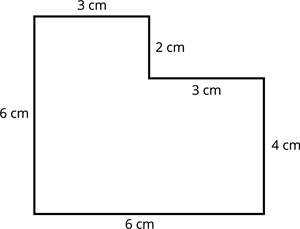UPSKILL MATH PLUS
Learn Mathematics through our AI based learning portal with the support of our Academic Experts!
Learn moreSo far, we have learnt how to find the perimeter and area of the shapes and combined shapes by applying the formula.
Let us learn how to find the perimeter and area of the shape after removing a portion from a given shape with an example.
Example:
Let us consider an example to understand the concept.
Consider a square whose side length is \(6\) \(cm\). Let us find the area and perimeter of the square.
Area, \(A=s \times s\)
\(A=6 \times 6\)
\(A=36\) \(sq. cm\)
Perimeter, \(P=4s\)
\(P=4\times 6\)
\(P=24\) \(cm\)
Now, let us cut a rectangle of length \(3 \ cm\) and breadth \(2 \ cm\) from the corner of the square and find the perimeter and area of the given shape.

Solution:
Given:
The side length of the square \(=6 \ cm\).
The length of the rectangle \(=3 \ cm\).
The breadth of the rectangle \(=2 cm\).
To find the perimeter and area of the square after removing the rectangle.
Perimeter of the given shape \(=\) Sum of all measures of outer length
Perimeter \(=\) \((3+6+6+4+3+2)\) \(cm\)
Perimeter \(=24\) \(cm\)
Therefore, the perimeter of the given shape is \(24\) \(cm\).
Area of the given shape \(=\) Area of square \(-\) Area of rectangle
Area of the given shape \(=\) \(s \times s\) \(-\) \(l \times b\)
\(=\) \(6 \times 6\) \(-\) \(3 \times 2\) \(sq. \ cm\)
\(= 36-6\) \(sq. cm\)
\(=30\) \(sq. cm\)
Therefore, the area of the given shape is \(30\) \(sq. \ cm\).
Here, the perimeter is not changed, but the area is decreased.
Hence, removing a portion from a given shape results in the area to be decreased.